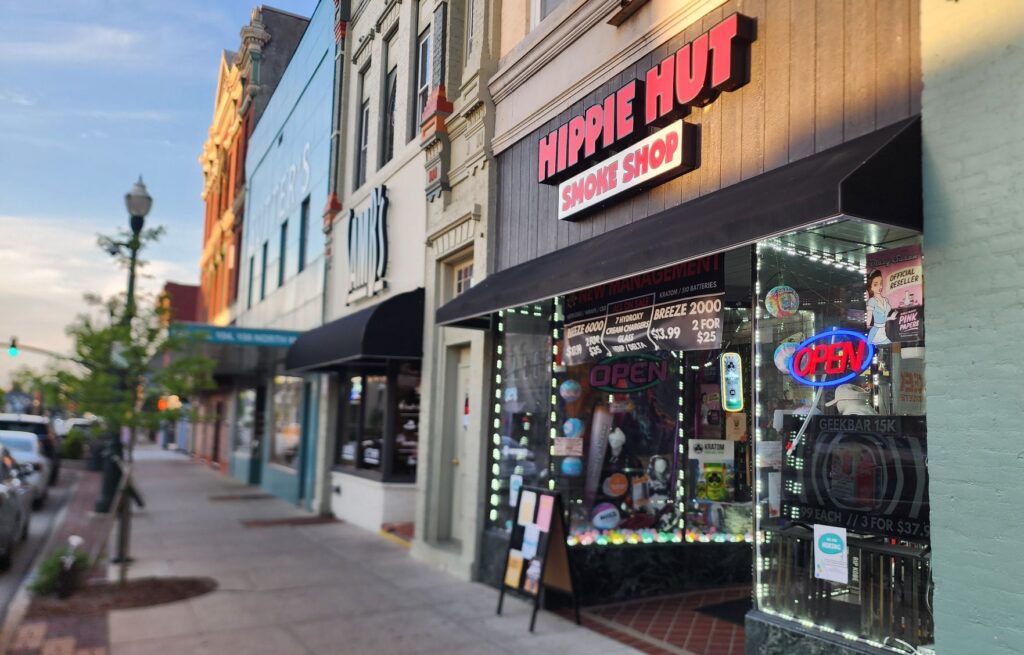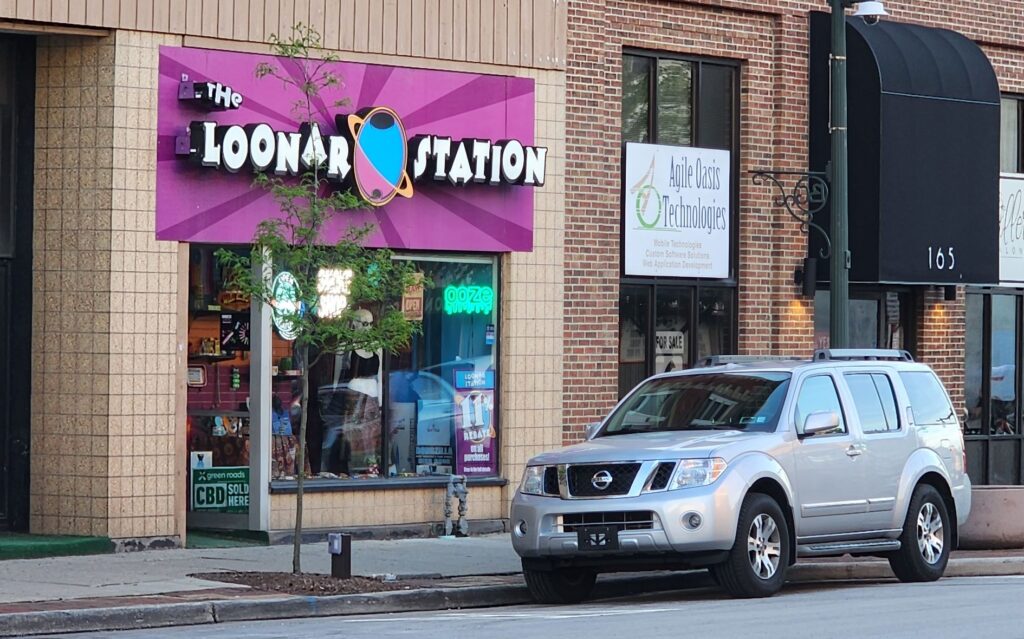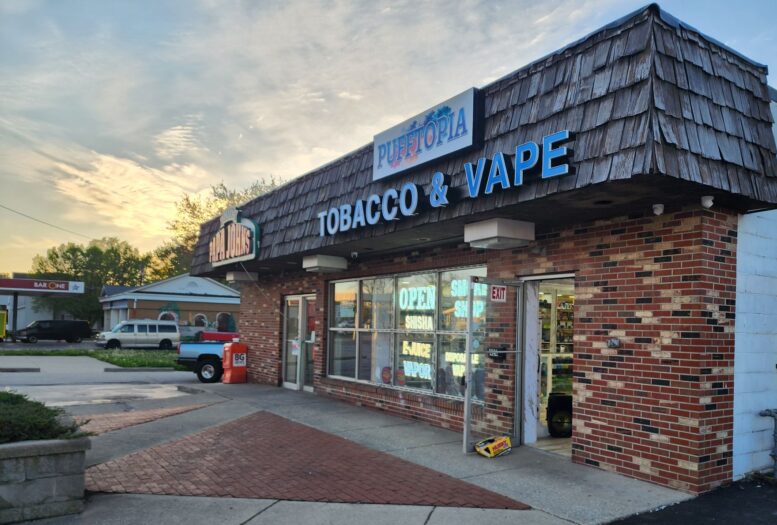By JAN McLAUGHLIN
BG Independent News
The Marlboro Man may have ridden into the sunset, but fruity and fun vapes are going strong. Four new vape and smoke shops opened in the first three months this year in Bowling Green – before the city put a moratorium on any more.
Bowling Green now has 12 vape and smoke shops, and at least 15 other businesses that sell vapes as a secondary item.
The names of the shops are playful – like Cosmic Haze, Happy Harvest, Butt Hut, Hippie Hut, Pufftopia, Loonar Station, Trophies Tobacco & Vape, and Wild Bill’s Tobacco.
But city officials, concerned about the public health effects of vaping, took action on April 7 to stop the proliferation of vape shops by placing a six-month moratorium on new vape and smoke shops in the city.
The moratorium legislation was spurred by reports of increasing numbers of youth vaping in the community.
On Wednesday evening, Bowling Green Planning Director Heather Sayler presented ideas for new zoning regulations of vape and smoke shops.
“We’re not trying to shut down anybody,” but just adopt reasonable regulations, Sayler said to members of the BG Planning Commission.
The regulations could define space requirements between vape and smoke shops and child-oriented locations in the city, could set a maximum number of shops based on the city’s population, and could limit the hours of operation and the number of signs.
“I could write up an initial draft of what makes sense for Bowling Green,” Sayler said.
Sayler talked about why so many vape and smoke shops are opening in Bowling Green – with the university and lower socio-economic population being a definite draw. Vape shops tend to have high profit margins, backed by huge marketing and a “cool factor,” she said.
“It’s a very attractive retail venture,” Sayler said.

During the six-month moratorium, the city will not accept, process or approve any new applications or issue any new permits, licenses, variances or any zoning applications from or for vape/smoke establishments in Bowling Green.
The moratorium will have no effect on those businesses currently operating.
Some council members, however, suggested that addressing the proliferation of vape shops would be better addressed through zoning.
Greg Robinette was opposed to the moratorium, suggesting the city look at zoning code changes instead to limit vape shops.
“I certainly have no affinity for vape, smoke shops, and the products they sell,” Robinette said. “But I’d rather attack this through the zoning code.”
Joel O’Dorisio supported the idea of zoning code changes in the long term, but favored a moratorium in the short term to stop the shops from “rapidly proliferating in the community.”
Municipalities have the power to enact planning and zoning laws for the health, safety, welfare, comfort and peace of citizens, including restricting areas used for business and trade.
But the six-month moratorium, which started April 7, doesn’t give city officials much time to write the zoning language and hold public hearings on the zoning change.
“The clock is running,” said Bob McOmber, chairman of the BG Planning Commission.
Sayler researched how other cities in Ohio were regulating vape and smoke shops. Kent has capped shops at 20 based on the city’s population. Oxford requires the shops to be licensed, and not be located near youth-oriented activities.
Cleveland limits window signage, requires new shops to be at least two miles from existing shops, and 500 feet from churches, libraries, playgrounds, parks or schools. Toledo requires special use permits, limits hours of operation, and must be approved by Toledo City Council. Sylvania requires posting of age warning signs, and regulates vape vending machines.

The vape and smoke shops in Bowling Green are clustered in the downtown area, the north end of North Main Street, the south end of South Main Street, and along East Wooster Street.
Members of the Planning Commission asked for time to digest Sayler’s report, as she works on the first draft of zoning language.
Vaping trends among youth and its health effects have been studied by at least two entities in Wood County – through the Behavioral Health Barometer among Wood County youth, and by the Wood County Health Department.
Wood County Health Commissioner Ben Robison spoke to City Council in April about the public health implications of vaping among youth. Vaping is the top method for youth to obtain nicotine.
Robison explained how recent visits to 53 stores selling vaping products in Wood County showed that most shops place e-cigarettes within reach and eye-level of children. The store audits, sought by the Ohio Department of Health, were recently conducted by Wood County Health Department.
The visits to local stores found that:
- Five stores had tobacco/nicotine products within one foot of products marketed toward children such as candy.
- 29 stores had tobacco/nicotine products within three feet of the floor – the eye level of the average 3-year-old.
- 39 stores had outdoor ads for tobacco products.
- 71% of stores had ads within three feet of the floor.
- 14 stores had no age restrictions posted.
The minimum age to legally purchase e-cigarettes in Ohio is 21, but placing them in reach and view of children can be tempting. Plus, e-cigs often come in bright colors, and in flavors that appeal to young people, like fruit, candy, menthol, and mint. And vapes are often sold out of vending machines.
The audit focused on youth and vaping because e-cigarettes are considered by some to be a safe alternative to smoking for youth. But the human brain is not done developing until approximately age 25. During the teenage years, the front part of the brain, called the prefrontal cortex, is still developing, Robison said.
Nicotine is a highly addictive substance that alters normal brain function. It creates a sense of pleasure that leads to cravings – that results in a cycle of dependency, Robison added.
According to the most recent survey by the Behavioral Health Barometer in 2021 among Wood County youth:
- Approximately 1,120 Wood County youth used e-cigarettes/vapes in the past year.
- 9% of youth vaped nicotine in the past 30 days.
- 5% of youth vaped marijuana in the past 30 days.
- 4% of youth vaped just flavoring (without any nicotine or marijuana) in the past 30 days.
In recent years, as public health saw the downward trend of cigarette smoking, it saw a climb in vaping. Smokers reportedly viewed vaping as a way to wean themselves off cigarettes, and others saw it as a safe alternative to cigarettes.
National studies have shown that 75% of college students have tried vaping nicotine, and nearly 25% use it every day. Vaping remains the most common method of nicotine consumption among adolescents, and seems to have replaced or supplemented the use of cigarettes.
Vaping is less conspicuous than cigarettes in public places, plus it’s marketed as “fruity” and “fresh” with flavors like watermelon and cotton candy. Vaping is promoted as chic – and compact, now being the size of a flash drive.





